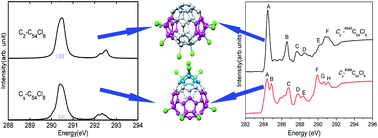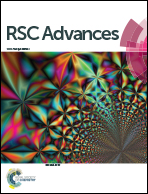Theoretical studies on the structural and spectral properties of two specific C54 isomers and the chlorinated species C54Cl8†
Abstract
X-ray photoelectron (XPS) and near-edge X-ray absorption fine structure (NEXAFS) spectra as well as the ground-state electronic/geometrical structures of #540C54 captured in experiment and the most controversial isomer #369C54 (C2v- and Cs-symmetry, respectively) have been calculated at the density functional theory (DFT) level. After chlorination, significant changes were observed in the electronic structure and X-ray spectra. Both XPS and NEXAFS spectra showed strong isomer dependence. The results indicated that the “fingerprints” in the X-ray spectra afforded an effective way to identify the fullerene isomers mentioned above. Ultraviolet-visible (UV-Vis) absorption spectroscopy of C54Cl8 was also simulated at the time-dependent (TD) DFT level, and the simulated UV-Vis spectrum was in accordance with the experimental result. The results of this study can provide valuable information for further experimental and theoretical studies of new fullerenes and their derivatives through X-ray and ultraviolet spectroscopy. The study of newly synthesized fullerene isomers and their derivatives using X-ray and UV-Vis spectra offers valuable information for further experimental and theoretical exploration.



 Please wait while we load your content...
Please wait while we load your content...